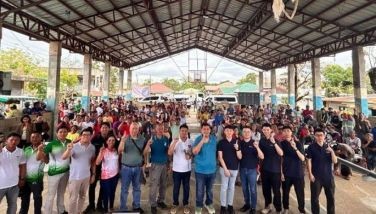The global vision for OneFC
OneFC chief executive officer Victor Cui is always joyous about flying back to the Philippines for his events. It always feels like a homecoming. His parents join him, as do immediate family from Cebu and Camiguin, and even dozens of undiscovered relatives celebrate his success. He laughs that even dozens of new “cousins” with similar-sounding surnames contact him via social networking sites to be part of the events, and with good reason. The Philippines has been one of the trailblazers for mixed martial arts in this part of the world.
“It’s at a different level in the Philippines, a different level of knowledge, a different level of awareness,” says Cui, who was once a struggling event organizer. “That’s been a bubble, because as we know, trends hit the Philippines the same time they hit the US, before they hit everywhere else in Asia. Whether it’s a brand or whether it’s a sport or something because of the strong ties to the US, and with English as a dominant language. It’s not the same outside. Now, it’s exploding in the rest of Asia.”
Proof of this is the almost geometric progression of number of events in the region. This year, OneFC has staged 10 events all over the continent, in 2015, that number will jump to 24, 10 in different cities in China alone. Three years ago, OneFC began with just one event. In the next few years, the goal will be to have an event broadcast live across Asia from a different place every Friday night all year round. That would make OneFC the lone sporting event broadcast weekly throughout the world’s largest market. They’re already halfway there, as the accelerated expansion has literally overtaken the organic growth in pioneering countries like the Philippines. The company will also be exploring new areas for growth like Mongolia and other Asian regions. One of the main reasons mixed martial arts has been so successful in Asia is the deep culture of martial arts, similar to the foundation of Greco-Roman wrestling which opened the MMA door for many college athletes in the US.
“The biggest difference, especially from an athletic perspective, is that martial arts is so ingrained in the culture here,” says OneFC vice-president and MMA legend Rich Franklin. “You loom at the fighters from the US, they’re not really martial artists. There was a period of time
wherein the basic transition for MMA in the US was anybody who wrestled in college. If you’re not going to wrestle in the Olympics, you have some way of competing. Prior to MMA, there was nothing for wrestlers in the United States. Here, in every country that you go to, there is a martial art ingrained. It’s part of that particular culture, and that helps us, because it gives the Asian fighters a base to build off of.”
Franklin cites two OneFC stalwarts. Jadamba Narantungalag is Mongolia’s first-ever world champion in the martial arts and is worshipped in his country as such, and their fighting traditions go back to centuries. This has propelled the sport’s growth in that country, and the possibility of a groundbreaking live event there. Women’s world boxing champion Ana Julaton was in her second OneFC fight last night, and is proof of how boxing is such a prevalent sport in the Philippines.
But whereas the wrestling foundation gives North American fighters a solid ground game, in Asia it’s the opposite, wherein most countries have solid striking in their arsenal, and are just learning to grapple. But this crossover appeal is actually combining the fight fans of Asia into one huge MMA market, and feeding the rivalries between styles and even countries to make for a very passionate fan base for OneFC, a happy circumstance for Cui, Franklin and company.
“Where OneFC is really exploding around the region is beyond the hardcore MMA fans, beyond the people that automatically, by sight, connect with it,” Cui explains enthusiastically. “We’re talking about reaching people, the younger and the older, females that have never followed MMA before, but have followed martial arts. They know their Bruce Lee and they have their heroes in Zhang Ziyi or Jackie Chan or whoever it might be. And those guys are now converted into MMA fans. And they’re the ones coming out in all the new countries that we go to. So you see this whole new celebrity-packed following of the sport in the region. That to me is really exciting, because it means that the sport is getting more and more mainstream.”
Cui also told this writer a story that sums up why he’s so excited about how pervasive mixed martial arts has become, when he did his first small event in the Philippines, he didn’t even have someone to wrap his fighters’ hands. Everyone knew how to wrap hands for boxing. But since the wraps are thicker, they couldn’t get their gloves on. Having to learn a lot of these things along the way has kept Cui grounded, and helped mold a philosophy of having to bring it every time to earn your title shots. Even though he is Filipino, he doesn’t coddle his Filipino fighters, Cui does not believe in paper champions.
Just two years ago, OneFC would pull together all the big media outlets to press gatherings only in the Philippines. Now, the same phenomenon occurs in many other countries in places like Taipei, Dubai, Jakarta and others. CCTV, the largest broadcaster in the world out of China, has even done full features on OneFC in both English and Mandarin. In some countries, OneFC events are on the front page of every broadsheet published there.
Cui is also excited about having boxing world champion Manny Pacquiao onboard as an investor and partner. Pacquiao himself is exploring ways to expand his brand even further throughout Asia, and they are trying to figure out how to do joint MMA and boxing events together. Pacquiao recognizes that, as his retirement approaches, he has no real successor to push boxing to the same level of acceptance and popularity that he has.
Wisely, OneFC’s marketing strategy already includes cross-promotion with other sports like MotoGP. Ticket packages for one event reward patrons with discounts and reservations for the other. This is a new territory that has been challenging for other large sports to explore, simply because of inter-brand competition for the same market. However, since live viewing of large sporting events is still relatively young in Asia, this packaging has proven somewhat effective. However, the bigger challenge in some locations is finding a suitable venue. In the Philippines for now, OneFC is satisfied to do two events a year in Metro Manila. There simply aren’t any new, air-conditioned arenas of an adequate size, unless organizers build an outdoor venue specifically for the purpose. Outside of basketball and volleyball, very few sporting events fill up coliseums regularly. In other Asian countries, that isn’t even the case.
In the next five years, OneFC will likely be one of the top sporting events and content providers in the world. It is based in a solid martial arts environment where audiences are still developing their taste for sporting events, and where fighters are now seeing opportunities to prosper. The upside looks very promising, indeed.
- Latest
- Trending




























